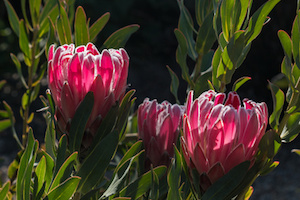Winter gardens have their own beauty – it’s time to put time into plants which will encourage bird and bee life in your garden over the cooler month, as well as those which can offer food.
Figs
Fig trees are an attractive addition to a garden, and fruit well – some varieties will produce two crops a year. Fresh figs are delicious eaten fresh, or roasted as a dessert, be preserved as a jam, or even served dried as an accompaniment to a cheese platter.
The trees themselves have large, lush-looking, deciduous foliage and are generally hardy. Young trees need some frost protection, and can be grown up and along walls, if space is at a premium in your garden. In a spot with well drained soil, figs will grow well against a sunny fence and provide a very attractive and edible screen. Figs can also be grown in a large container.
 Proteas
Proteas
There are many fantastic varieties of proteas that flower during winter so now is an ideal time to visit your local nursery and choose one for your garden. Proteas range in colour from creamy white and yellow through to light pink and port wine red and some proteas have very attractive black fringing on the flowers.
Proteas also make a beautiful and long lasting cut flower for your fresh indoor arrangements.
Most varieties grow between one and two metres tall and are moderately tolerate of frost. Another grea advantage of having proteas in your garden is that they attract native birds (for example tuis). While in flower, they provide an important source of food for both birds and bees during the cooler months.
After they flower, prune off about half of each stem that has flowered – this will help keep the plant compact and tidy.
Indoor winter plants
Your indoor plants need less moisture during the winter, so water them less to avoid water logging. Both under and over watering cause most common problems with indoor plants. Don’t leave water in indoor plant saucers as this can leave the lowest layers of potting mix permanently wet, which can lead to rotted roots and poor plant health.
If you are unsure of the moisture levels in your potted plants, gently scratch around in the top few centimetres of potting mix. If it feels dry and dusty then the plant can be re-watered. If the potting mix sticks to your finger then leave watering for a few more days.
Give your indoor plants a general tidy up at this time of year, by removing any dead foliage or flowers and cleaning up any dust. Dust can also impact plant health and their ability to improve air quality. For small plants, delicately wipe over the leaves with a damp cloth, supporting each leaf as you wipe to help prevent tearing the leaves. For larger plants, you can move them into the shower and give them a gentle wash with lukewarm water.










Join the Discussion
Type out your comment here:
You must be logged in to post a comment.